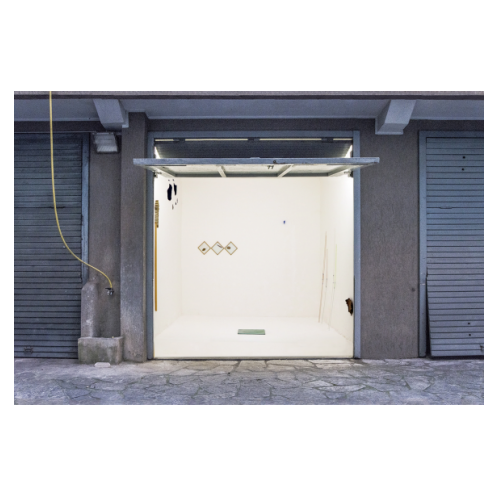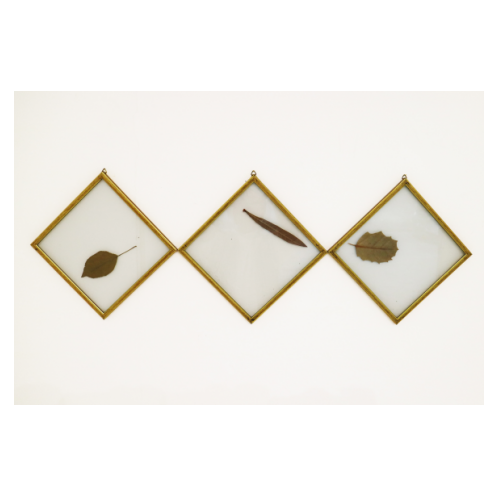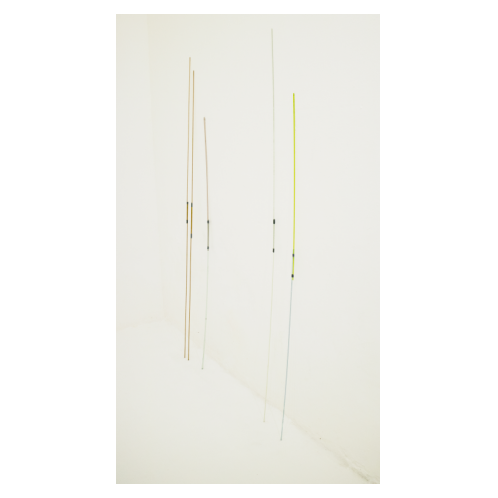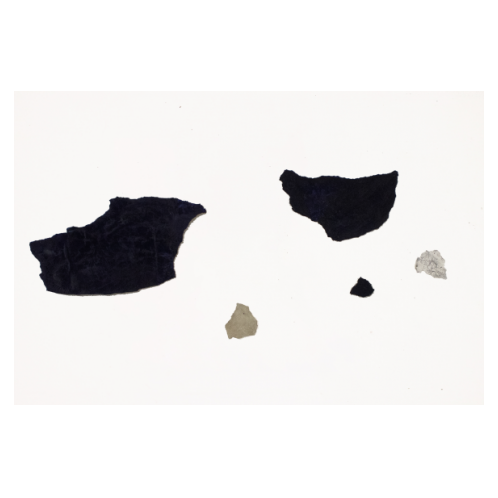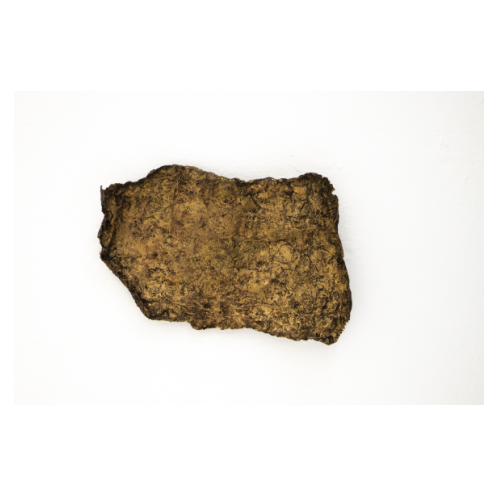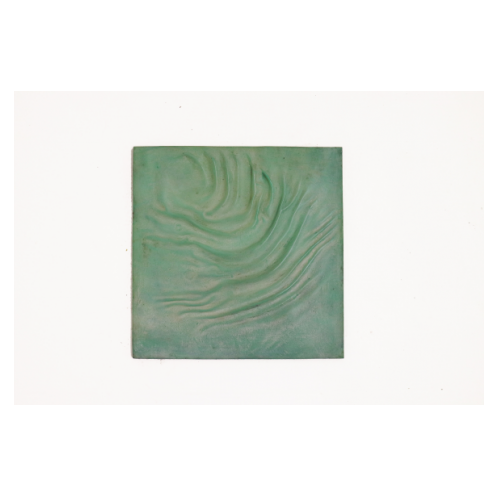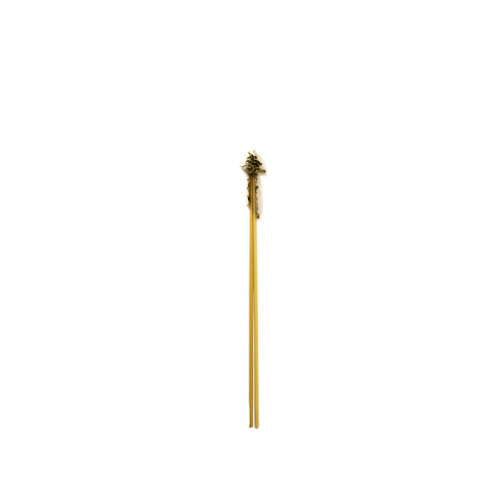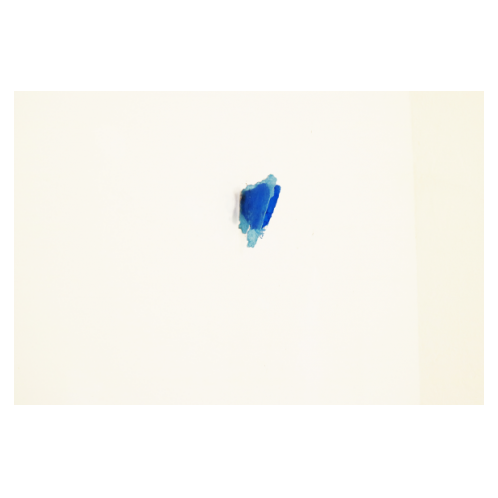Levitas
THE OPEN BOX
LEVITAS
PIPPA BACCA – ALICE CATTANEO – BARBARA COLOMBO – LÉA DUMAYET – ARIANNA GIORGI
a cura di
GIORGIO VERZOTTI
dal 13 settembre al 30 ottobre 2021
Pippa Bacca (Milano, 1974-Gebze, 2008) ritaglia le foglie degli alberi più comuni e le trasforma in foglie altre, inventa una nuova botanica e la inserisce in una tassonomia imprevedibile, inventata all’uopo, paralogica.
Alice Cattaneo (Milano, 1976) estremizza il “per via di levare” associabile alla scultura riducendo l’opera alle dimensioni di un’esile bacchetta di vetroresina e di legno di balsa, leggerissima e appena distinguibile dalla parete a cui è appoggiata.
Barbara Colombo (Vimercate, 1969) destruttura la corposità dei suoi monocromi, frutto di sovrapposizioni di materie diverse, riducendoli a congerie di frammenti allacciati alla parete, e gioca anche all’inganno visivo presentando come leggero ciò che è in realtà pesante.
Un approccio che ritroviamo anche in Léa Dumayet (Parigi, 1990); l’artista, in un sottile gioco mimetico, ci restituisce una superficie di bronzo verdastro come fosse uno specchio d’acqua lievemente solcata da piccole onde.
Arianna Giorgi (Milano, 1965) adotta elementi di plastica o cera o anche piccoli oggetti fatti dei materiali più diversi e crea figure di elevazione, di sfida alla gravità dei corpi che è anche rivalsa dei suoi materiali poveri cui attribuisce fascino e preziosità.
Le loro strategie espressive non si risolvono in quello che viene qui sopra descritto, tuttavia possiamo dire che la leggerezza è il tratto comune di queste artiste, e va intesa in un senso semanticamente ampio. Liberarsi dal peso delle cose, della materia, della densità, vale intanto come metafora della funzione dell’arte, che ci libera momentaneamente dalla grevità della nostra esistenziale alienazione.
Vale poi il desiderio di superare il peso, l’ipoteca, dei canoni, qualunque essi siano, in nome di una libertà di sperimentazione davvero incondizionata. Questo percorso, ovviamente non univoco, avviene per riduzione, assottigliamento, parziale perdita. È come se si sentisse il bisogno non del “grado zero” da cui ripetutamente l’avanguardia è (ri)partita, ma di un indebolimento dei canoni espressivi che consenta nuove sintesi di senso fondate sulla semplicità degli assunti, di contro alla complessità incombente nella sfera comunicazionale. Semplicità che si rivela capace di svelare l’apparato ideologico che direziona tale comunicazione.
Si tratta di una “leggerezza della pensosità” come voleva Italo Calvino che nella prima delle sue Lezioni Americane citava Paul Valéry: “Il faut être léger comme l’oiseau et non comme la plume”. Seguendo Calvino diciamo che la leggerezza qui si associa alla determinazione, non alla vaghezza e all’abbandono al caso. Però essa anche si dissocia dalla dittatura del significato, il pensiero intuitivo aleggia più liberamente e proficuamente, trova più possibilità di galleggiare nell’indeterminato, essendo qui la suggestione il tramite aperto fra l’opera e l’osservatore e diafano, quasi trasparente, quasi immateriale lo strumento.
Nessuna ingenuità qui alligna. Liberarsi da un peso significa anche estraniarsi dal dramma che si vive direttamente e osservarsi, osservare quel nucleo problematico come dall’esterno, alleggerirlo per poterlo valutare. E accorgersi magari di inaspettate equivalenze. La leggerezza contiene anche la gravità, e viceversa, nel senso almeno che l’una tematizza l’altra come possibilità, o addirittura come suo compimento.
Sono queste del resto le imprevedibili capacità del pensiero, e i percorsi sempre sorprendenti dell’arte.
Alice Cattaneo (Milano, 1976) estremizza il “per via di levare” associabile alla scultura riducendo l’opera alle dimensioni di un’esile bacchetta di vetroresina e di legno di balsa, leggerissima e appena distinguibile dalla parete a cui è appoggiata.
Barbara Colombo (Vimercate, 1969) destruttura la corposità dei suoi monocromi, frutto di sovrapposizioni di materie diverse, riducendoli a congerie di frammenti allacciati alla parete, e gioca anche all’inganno visivo presentando come leggero ciò che è in realtà pesante.
Un approccio che ritroviamo anche in Léa Dumayet (Parigi, 1990); l’artista, in un sottile gioco mimetico, ci restituisce una superficie di bronzo verdastro come fosse uno specchio d’acqua lievemente solcata da piccole onde.
Arianna Giorgi (Milano, 1965) adotta elementi di plastica o cera o anche piccoli oggetti fatti dei materiali più diversi e crea figure di elevazione, di sfida alla gravità dei corpi che è anche rivalsa dei suoi materiali poveri cui attribuisce fascino e preziosità.
Le loro strategie espressive non si risolvono in quello che viene qui sopra descritto, tuttavia possiamo dire che la leggerezza è il tratto comune di queste artiste, e va intesa in un senso semanticamente ampio. Liberarsi dal peso delle cose, della materia, della densità, vale intanto come metafora della funzione dell’arte, che ci libera momentaneamente dalla grevità della nostra esistenziale alienazione.
Vale poi il desiderio di superare il peso, l’ipoteca, dei canoni, qualunque essi siano, in nome di una libertà di sperimentazione davvero incondizionata. Questo percorso, ovviamente non univoco, avviene per riduzione, assottigliamento, parziale perdita. È come se si sentisse il bisogno non del “grado zero” da cui ripetutamente l’avanguardia è (ri)partita, ma di un indebolimento dei canoni espressivi che consenta nuove sintesi di senso fondate sulla semplicità degli assunti, di contro alla complessità incombente nella sfera comunicazionale. Semplicità che si rivela capace di svelare l’apparato ideologico che direziona tale comunicazione.
Si tratta di una “leggerezza della pensosità” come voleva Italo Calvino che nella prima delle sue Lezioni Americane citava Paul Valéry: “Il faut être léger comme l’oiseau et non comme la plume”. Seguendo Calvino diciamo che la leggerezza qui si associa alla determinazione, non alla vaghezza e all’abbandono al caso. Però essa anche si dissocia dalla dittatura del significato, il pensiero intuitivo aleggia più liberamente e proficuamente, trova più possibilità di galleggiare nell’indeterminato, essendo qui la suggestione il tramite aperto fra l’opera e l’osservatore e diafano, quasi trasparente, quasi immateriale lo strumento.
Nessuna ingenuità qui alligna. Liberarsi da un peso significa anche estraniarsi dal dramma che si vive direttamente e osservarsi, osservare quel nucleo problematico come dall’esterno, alleggerirlo per poterlo valutare. E accorgersi magari di inaspettate equivalenze. La leggerezza contiene anche la gravità, e viceversa, nel senso almeno che l’una tematizza l’altra come possibilità, o addirittura come suo compimento.
Sono queste del resto le imprevedibili capacità del pensiero, e i percorsi sempre sorprendenti dell’arte.
THE OPEN BOX
Via G.B. Pergolesi 6
20124
MILANO
www.theopenbox.org
info.theopenbox.org@gmail.com
+393382632596
![]()
THE OPEN BOX
LEVITAS
PIPPA BACCA – ALICE CATTANEO – BARBARA COLOMBO – LÉA DUMAYET – ARIANNA GIORGI
curated by
GIORGIO VERZOTTI
from 13 September to 30 October 2021
Pippa Bacca (Milan, 1974-Gebze, 2008) cuts the leaves of the most common trees, transforming them into other leaves; she invents a new botany and inserts it within an unpredictable, paralogical taxonomy, invented for the purpose.
Alice Cattaneo (Milan, 1976) takes to the extreme that “by means of removal” associable with sculpture, reducing the work of art to the dimensions of a slim wand in fibreglass and balsa wood, incredibly light and barely distinguishable from the wall on which it leans.
Barbara Colombo (Vimercate, 1969) deconstructs the corporality of her monochromes, the result of the overlaying of diverse materials, reducing them to amassed fragments attached to the wall, and she also plays with the visual deception, presenting as light that which in reality is heavy.
An approach we also find in the work of Léa Dumayet (Paris, 1990); in a subtle mimetic play, she presents a sheet of greenish bronze as if it were a lightly rippled pool of water.
Arianna Giorgi (Milan, 1965) adopts elements in plastic or wax or perhaps small objects made of the most diverse materials to create figures of elevation, of challenges to the gravity of bodies that also compensate for the poverty of her materials to which they add appeal and enrichment.
While their expressive strategies are not fully resolved in what is described above, we can nonetheless say that lightness is the common trait of these artists and is to be understood in a semantically broad sense. Freeing oneself of the weight of things, of matter, of density can been seen as a metaphor for the function of art, which momentarily frees us of the coarseness of our existential alienation.
Then there is the desire to overcome weight, the commitment, the canons, whatever they might be, in the name of a truly unconditioned freedom of experimentation. This path, while clearly not univocal, is established by reduction, by thinning, by partial loss. It as is if they felt the need not for the “zero degree” from which the avant-garde repeatedly restarted, but for a softening of the expressive canons that permits new syntheses of meaning based on the simplicity of the hypotheses, in contrast with the overbearing complexity of the communications sphere. A simplicity that proves capable of revealing the ideological apparatus that directs such communication.
This is a “lightness of thoughtfulness” as suggested by Italo Calvino, who in the first of his American Lectures cited Paul Valéry: “Il faut être léger comme l’oiseau et non comme la plume”. Following Calvino, we might say that here lightness is associated with determination, rather than vagueness and abandonment to chance.
However, it also disassociates itself from the dictatorship of meaning, intuitive thought hovers more freely and profitably, finding more opportunities to float in the undetermined, with suggestion being the open link between work and observer and the instrument being diaphanous, almost transparent, almost immaterial.
No innocence prospers here. Freeing oneself of a weight also means distancing oneself from directly experienced drama and observing oneself, observing that problematic nucleus as if from the outside, lightening it in order to be able to evaluate it. And perhaps notice unexpected equivalencies. Lightness also contains gravity and vice versa, in the sense that at least one thematizes the other as possibility, or even as its completion.
These are, after all, the unpredictable capacities of thought, and the ever-surprising paths of art.
Alice Cattaneo (Milan, 1976) takes to the extreme that “by means of removal” associable with sculpture, reducing the work of art to the dimensions of a slim wand in fibreglass and balsa wood, incredibly light and barely distinguishable from the wall on which it leans.
Barbara Colombo (Vimercate, 1969) deconstructs the corporality of her monochromes, the result of the overlaying of diverse materials, reducing them to amassed fragments attached to the wall, and she also plays with the visual deception, presenting as light that which in reality is heavy.
An approach we also find in the work of Léa Dumayet (Paris, 1990); in a subtle mimetic play, she presents a sheet of greenish bronze as if it were a lightly rippled pool of water.
Arianna Giorgi (Milan, 1965) adopts elements in plastic or wax or perhaps small objects made of the most diverse materials to create figures of elevation, of challenges to the gravity of bodies that also compensate for the poverty of her materials to which they add appeal and enrichment.
While their expressive strategies are not fully resolved in what is described above, we can nonetheless say that lightness is the common trait of these artists and is to be understood in a semantically broad sense. Freeing oneself of the weight of things, of matter, of density can been seen as a metaphor for the function of art, which momentarily frees us of the coarseness of our existential alienation.
Then there is the desire to overcome weight, the commitment, the canons, whatever they might be, in the name of a truly unconditioned freedom of experimentation. This path, while clearly not univocal, is established by reduction, by thinning, by partial loss. It as is if they felt the need not for the “zero degree” from which the avant-garde repeatedly restarted, but for a softening of the expressive canons that permits new syntheses of meaning based on the simplicity of the hypotheses, in contrast with the overbearing complexity of the communications sphere. A simplicity that proves capable of revealing the ideological apparatus that directs such communication.
This is a “lightness of thoughtfulness” as suggested by Italo Calvino, who in the first of his American Lectures cited Paul Valéry: “Il faut être léger comme l’oiseau et non comme la plume”. Following Calvino, we might say that here lightness is associated with determination, rather than vagueness and abandonment to chance.
However, it also disassociates itself from the dictatorship of meaning, intuitive thought hovers more freely and profitably, finding more opportunities to float in the undetermined, with suggestion being the open link between work and observer and the instrument being diaphanous, almost transparent, almost immaterial.
No innocence prospers here. Freeing oneself of a weight also means distancing oneself from directly experienced drama and observing oneself, observing that problematic nucleus as if from the outside, lightening it in order to be able to evaluate it. And perhaps notice unexpected equivalencies. Lightness also contains gravity and vice versa, in the sense that at least one thematizes the other as possibility, or even as its completion.
These are, after all, the unpredictable capacities of thought, and the ever-surprising paths of art.
THE OPEN BOX
Via G.B. Pergolesi 6
20124
MILANO
www.theopenbox.com
info.theopenbox.org@gmail.com
+393382632596

